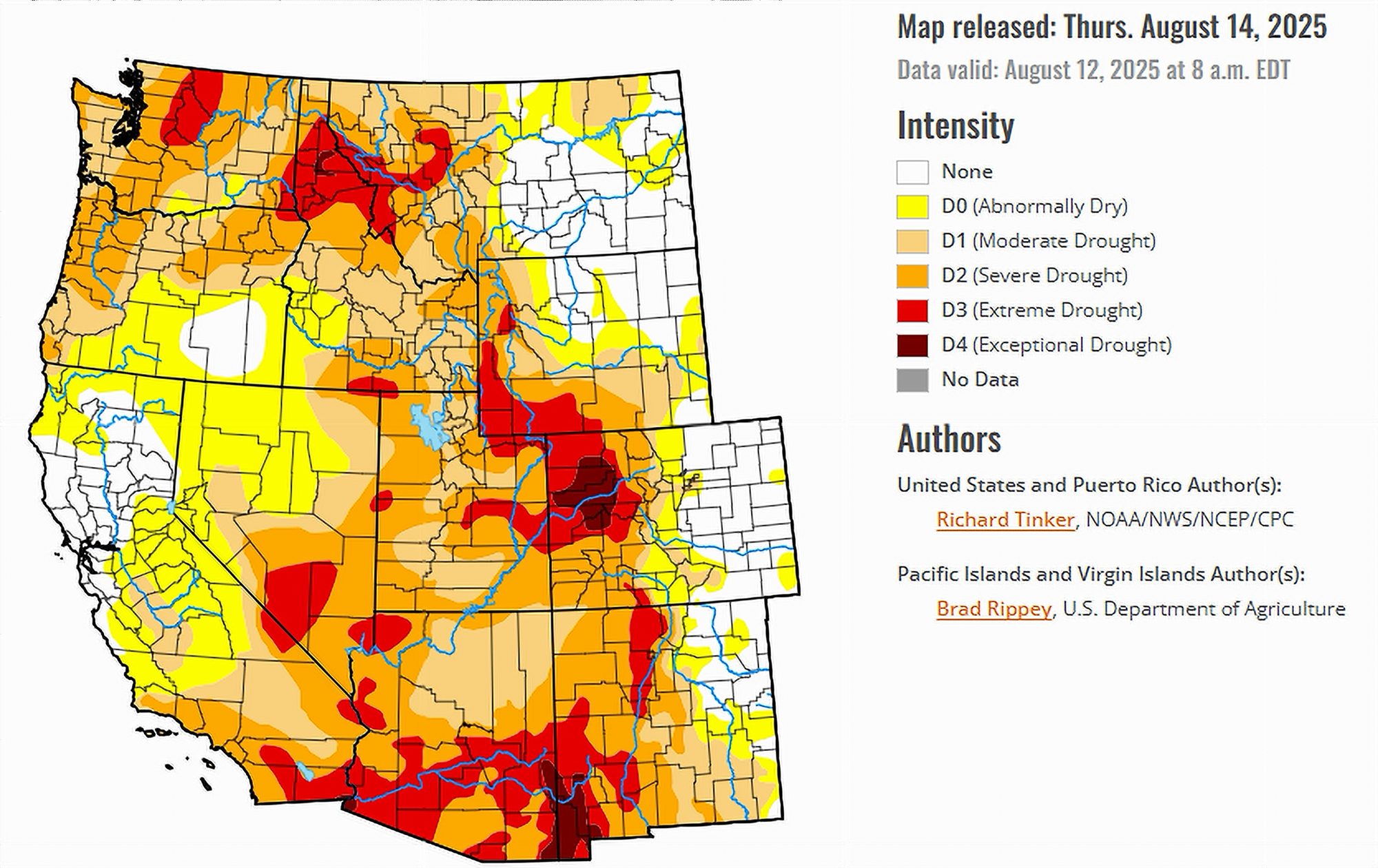- Dryness intensified across much of the U.S. in mid-August.
- Exceptional drought spread in western Colorado and Wyoming.
- Arizona and Utah saw worsening drought after weak monsoon rains.
- California and Nevada held steady, but remained very dry.
Saturday, August 16, 2025 — The U.S. Drought Monitor released on August 14, 2025, reported expanding and intensifying drought across large portions of the country. The report describes “Intensifying short-term rainfall shortages led to expanding and intensifying dryness and drought over much of the Lower Mississippi Valley, Ohio Valley, Tennessee Valley, Northeast, and parts of the Deep South, southern Plains, central Arizona, and the central Rockies.” While some areas benefited from significant rainfall—such as the Carolinas, Florida, and parts of the northern Rockies—many regions continued to dry out. Southeast Wisconsin received as much as 11 inches of rain, but conditions deteriorated across the Northeast and parts of the Plains.
released on August 14, 2025, reported expanding and intensifying drought across large portions of the country. The report describes “Intensifying short-term rainfall shortages led to expanding and intensifying dryness and drought over much of the Lower Mississippi Valley, Ohio Valley, Tennessee Valley, Northeast, and parts of the Deep South, southern Plains, central Arizona, and the central Rockies.” While some areas benefited from significant rainfall—such as the Carolinas, Florida, and parts of the northern Rockies—many regions continued to dry out. Southeast Wisconsin received as much as 11 inches of rain, but conditions deteriorated across the Northeast and parts of the Plains.
Focus on the Colorado River Basin.
The seven states that depend on the Colorado River—Arizona, California, Colorado, Nevada, New Mexico, Utah, and Wyoming—saw mixed but mostly concerning conditions in the latest report.
Colorado and Wyoming: Severe Deterioration.
The most significant drought expansion occurred in Colorado and Wyoming. “A sizeable swath of northwestern Colorado deteriorated into exceptional drought (D4), and D2 to D3 conditions expanded in other areas over and near the higher elevations in western parts of the High Plains Region,” according to the U.S. Drought Monitor .
.
Colorado’s agricultural impacts are mounting. Nineteen percent of the corn crop is now rated poor or very poor, compared with just one percent in early July. Wyoming’s topsoil moisture shortages also worsened, with 63 percent now short or very short of moisture.
Arizona and Utah: Weak Monsoon, Growing Drought.
In Arizona and Utah, the summer monsoon rains have not been strong enough to bring relief. “A few weeks of deficient monsoonal rainfall and above-normal temperatures prompted deterioration in D1 to D3 conditions across…several swaths across Utah, and a few areas in Arizona,” the report noted.
This pattern has raised concerns for rangeland conditions. In Utah, nearly half of rangelands are now in poor or very poor condition, a jump from just one-third earlier in the summer.
Nevada and California: Holding Steady, But Dry.
Nevada and California saw little change in conditions, with “little or no precipitation forecast across California [and] the Great Basin.” Dryness and drought remained widespread, but not significantly different from the previous week. The absence of incoming storms points to continued stress on water supplies.
New Mexico: Localized Dryness.
New Mexico’s conditions were essentially unchanged. While some abnormal dryness and moderate drought persisted, the state did not experience the sharp deterioration seen in Colorado, Utah, and Arizona.
Forecasts Predict Limited Relief.
Forecasts for mid- to late August show limited relief for the Colorado River Basin. Rain is expected in parts of Colorado’s high country and southern Arizona, but much of California, Nevada, and Utah will likely remain dry. With hot temperatures also expected to persist, drought stress is poised to continue across the region.

